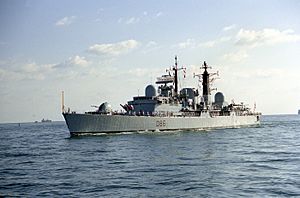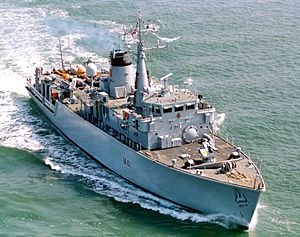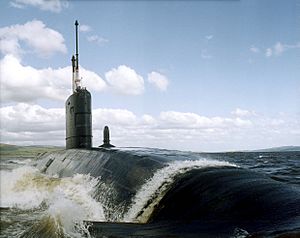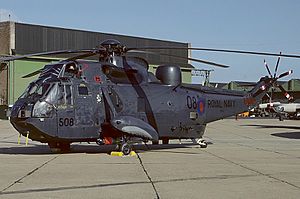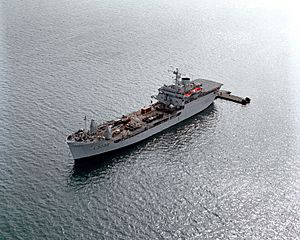Outline of the British Royal Navy at the end of the Cold War facts for kids
The Royal Navy in 1989 was a very important part of the United Kingdom's defence. It was managed by the Navy Department within the UK's Ministry of Defence. At this time, the Royal Navy had two main commands: the Commander-in-Chief Fleet (CINCFLEET) and the Naval Home Command.
The top leader of the Royal Navy was the First Sea Lord and Chief of the Naval Staff. In May 1989, Admiral Sir Julian Oswald took on this important job. He was in charge of the entire Her Majesty's Naval Service. The Royal Navy had about 65,500 people serving in 1989, including both men and women, and the brave Royal Marines.
At the end of the Cold War in 1989, the Royal Navy had a clear structure to keep everything running smoothly.
The First Sea Lord's Team
The First Sea Lord and Chief of the Naval Staff (often called 1SL/CNS) worked in Whitehall, London. He had a team of senior officers who helped him manage different parts of the Navy:
- The Second Sea Lord was an Admiral in charge of all Navy personnel (the people) and shore bases.
- The Controller of the Navy was an Admiral responsible for getting new equipment and supplies for the Navy.
- The Chief of Fleet Support was a Vice Admiral who looked after the dockyards and made sure ships were maintained.
- The Assistant Chief of the Naval Staff was a Rear Admiral who led the main Navy staff.
- The Naval Secretary was a Rear Admiral who handled policies about managing Navy personnel.
- The Hydrographer of the Navy was a Rear Admiral in charge of mapping the seas.
The Naval Service included several important groups:
- The Royal Navy (the main fighting force), including the Royal Naval Reserve (part-time sailors).
- The Royal Marines (specialist commandos), including the Royal Marines Reserve.
- The Royal Fleet Auxiliary (civilian ships that support the Navy).
- The Women's Royal Naval Service (WRNS), which was the women's branch of the Navy.
- The Queen Alexandra's Royal Naval Nursing Service (QARNNS), which provided nurses for the Navy.
Commander-in-Chief Fleet (CINCFLEET)
The Commander-in-Chief Fleet (CINCFLEET) was an Admiral based at Northwood Headquarters. He was in charge of all the Royal Navy and Royal Marines ships, submarines, aircraft, and personnel. He also had important roles in NATO, commanding naval forces in the Eastern Atlantic and the English Channel. CINCFLEET made sure that all the Navy's fighting units were ready for action and well-trained.
First Flotilla
The Flag Officer First Flotilla (FOF1) was a Rear Admiral based at HMNB Portsmouth. He commanded the Navy's First Flotilla, which included several squadrons of frigates and destroyers:
- 1st Frigate Squadron with Type 22 frigates (Batch 2).
- 2nd Frigate Squadron with Type 22 frigates (Batch 1).
- 5th Destroyer Squadron with Type 42 destroyers.
- 6th Frigate Squadron with Leander-class frigates (Batch 3A).
- The Dartmouth Training Squadron, which included the Type 82 destroyer: HMS Bristol.
Second Flotilla
The Flag Officer, Second Flotilla was a Rear Admiral based at HMNB Devonport. He commanded the Navy's Second Flotilla, which also had various squadrons of destroyers and frigates:
- 3rd Destroyer Squadron with Type 42 destroyers.
- 4th Frigate Squadron with Type 21 frigates.
- 7th Frigate Squadron with Leander-class frigates (Batch 2).
- 8th Frigate Squadron with Type 22 frigates (Batch 3).
Third Flotilla
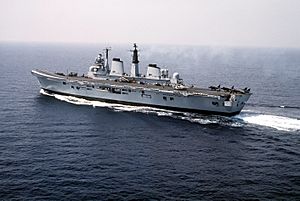
The Flag Officer, Third Flotilla was a Rear Admiral based at HMNB Portsmouth. He commanded the Navy's Third Flotilla and also served as NATO's Commander Anti-Submarine Warfare Striking Force. This flotilla was very important because it included all the Navy's aircraft carriers and amphibious assault ships. In 1989, these included:
- HMS Invincible
- HMS Illustrious
- HMS Ark Royal
- HMS Intrepid (an amphibious assault ship)
- Support ships like RFA Argus and the ice patrol vessel HMS Endurance.
The Flag Officer Scotland and Northern Ireland (FOSNI) was a Vice Admiral based near Rosyth. He commanded the Navy's units in Scotland and Northern Ireland. He also had NATO roles. His main units included:
- The Mine Countermeasures Flotilla, based at Rosyth Dockyard, which had several squadrons of mine-hunting ships like the Hunt-class mine countermeasures vessels. These ships are designed to find and safely remove sea mines.
- The Fishery Protection Squadron, which used patrol vessels to protect fishing areas.
- The Northern Ireland Patrol Squadron, based in Belfast Harbour, which patrolled the waters around Northern Ireland.
Submarine Command
The Flag Officer Submarines (FOSM) was a Rear Admiral based at Northwood Headquarters. He was in charge of the entire Royal Navy Submarine Service and also led NATO's submarine forces in the Eastern Atlantic. The submarine fleet was divided into several squadrons:
- 1st Submarine Squadron with Oberon-class submarines.
- 2nd Submarine Squadron with powerful Swiftsure-class submarines and newer Trafalgar-class submarines.
- 3rd Submarine Squadron with more Oberon-class submarines, Churchill-class submarines, and Valiant-class submarines, plus more Swiftsure-class submarines.
- 10th Submarine Squadron which operated the Resolution-class ballistic missile submarines, which carried nuclear missiles.
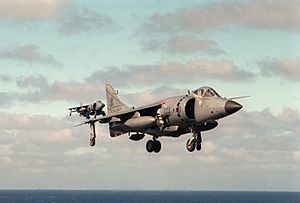
The Flag Officer Naval Air Command (FONAC) was a Rear Admiral based at RNAS Yeovilton. He commanded the Fleet Air Arm, which is the Navy's aviation branch. This command included various air stations and squadrons:
- RNAS Prestwick had squadrons like 819 Naval Air Squadron and 824 Naval Air Squadron flying Sea King helicopters for anti-submarine warfare.
- RNAS Yeovilton was home to squadrons flying Sea Harrier jets (like 800 Naval Air Squadron and 801 Naval Air Squadron) and Sea King helicopters for air assault (like 845 Naval Air Squadron).
- RNAS Culdrose had squadrons for helicopter training, search and rescue, and anti-submarine warfare, also using Sea King helicopters.
- RNAS Portland had squadrons flying Lynx helicopters, which were often deployed on frigates and destroyers.
Royal Marines Command

The Commandant General Royal Marines was the head of the Royal Marines. In 1989, this was Lieutenant General Sir Martin Garrod. The Royal Marines are highly trained commandos, ready for special operations.
- The 3 Commando Brigade was the main fighting unit of the Royal Marines, based in Plymouth. It was a light amphibious brigade, meaning it could be deployed quickly by sea. It included:
- Different Commando units like 40 Commando, 42 Commando, and 45 Commando.
- Assault Squadrons with landing craft to get troops ashore.
- An Air Squadron with Gazelle and Lynx helicopters.
- Support units from the British Army, such as artillery (like 29 Commando Regiment Royal Artillery) and engineers.
- The Comacchio Group was based at HMNB Clyde and guarded important naval sites, including the UK's naval nuclear weapons.
- The Commando Training Centre Royal Marines at Lympstone was where all Royal Marines received their tough training.
- The Special Boat Service (SBS) was the Royal Marines' special forces unit, focusing on maritime and amphibious missions.
The Flag Officer Gibraltar, who was also the Gibraltar Naval Base Commander, was a Rear Admiral based in Gibraltar. He commanded the Navy's units there and also had a NATO role for the Mediterranean. The Gibraltar Squadron included patrol vessels like HMS Cormorant.
The Commander-in-Chief Naval Home Command (CINCNAVHOME) was an Admiral based at HMNB Portsmouth. This command was mainly responsible for administrative tasks and supporting the Navy's operations.
Sea Training
The Flag Officer Sea Training (FOST) was a Rear Admiral based at RN Dockyard Portland. His job was to make sure all Navy units were properly trained for operations at sea.
Training and Recruitment
The Flag Officer, Training and Recruitment (FOTR) was a Rear Admiral based at HMNB Portsmouth. He was responsible for finding new recruits and giving them their basic training. This included:
- HMS Raleigh, for entry and basic training.
- HMS Sultan, for engineering training.
- The Britannia Royal Naval College in Dartmouth, where future Navy officers were trained.
The Flag Officer Reserves (FOR) was a Rear Admiral responsible for the Royal Naval Reserve (RNR). The RNR is made up of part-time sailors who train regularly and would help man ships, especially minesweepers, in times of need. Each RNR Division had a minesweeper assigned for training.
Royal Fleet Auxiliary
The Royal Fleet Auxiliary (RFA) was a fleet of civilian-manned ships owned by the Ministry of Defence. Their main job was to support the Royal Navy by supplying fuel, ammunition, and other goods to warships at sea. They also transported Army and Royal Marine personnel. RFA ships had the prefix "RFA" before their names. In 1989, the RFA included:
- Repair ships like RFA Diligence.
- Landing and logistics ships like RFA Sir Bedivere and RFA Sir Galahad.
- Tankers like RFA Olwen and RFA Green Rover for refueling ships at sea.
- Fleet replenishment ships like RFA Fort Grange that carried many different supplies.

The Royal Naval Auxiliary Service (RNXS) was a group of civilian volunteers who were trained by the Royal Navy. Their role was to help manage UK ports and guide merchant ships in emergencies. They had their own training ships, known as the "Loyals," and also used four Archer-class patrol vessels for training.
Royal Maritime Auxiliary Service
The Royal Maritime Auxiliary Service (RMAS) was a civilian agency that operated various support vessels for the Navy. These included ships for transporting ammunition, research, salvage, and tugboats for moving larger ships in harbours.
The Women's Royal Naval Service (WRNS) was the women's branch of the Naval Service. WRNS personnel worked in shore establishments, supporting the Navy's operations from land.
The Royal Corps of Naval Constructors was a group of civilian experts who designed and built naval ships. They were trained in naval architecture and engineering.
The Queen Alexandra's Royal Naval Nursing Service (QARNNS) was the nursing branch of the Naval Service. They provided medical care for sailors and marines in naval hospitals, aid stations, and on ships.
Other Important Units
- Naval Party 1002 was a mixed Royal Navy and Royal Marines unit based on Diego Garcia to support US Navy and Air Force bases.
- Naval Party 1022 was based in Sembawang, Singapore, as part of the UK's defence agreements with other countries.



